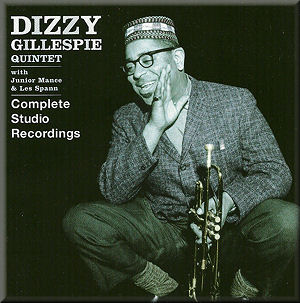CD1
1. My Heart Belongs to Daddy
2. My Man
3. Moonglow
4, St Louis Blues
5. Woody 'n' You
6. Wrap Your Troubles in Dreams
7. There is No Greater Love
8. I Found a Million Dollar Baby (In the Five and Ten Cent Store)
9. Swing Low, Sweet Cadillac
10. Always
11. Willow Weep for Me
12. Ungawa
13. Lorraine
CD2
1. Girl of my Dreams
2. Constantinople
3. The Umbella Man
4. Squatty Roo
5. Oo-Shoo-Be-Doo-Be
6. I Found a Million Dollar Baby (In the Five and Ten Cent Store)
7. There is No Greater Love (alternate take 1)
8. There is No Greater Love (alternate take 2)
9. There is No Greater Love (alternate take 3)
10. Sugar Hips
11. One Alone (Lonely One)
12. Hey Pete! Let's Eat More Meat
13. Money Honey
14. Blue Mood
15. Rails
16. Devil and the Flesh
17. Rumbola
Dizzy Gillespie - Trumpet, vocals
Junior Mance - Piano
Les Spann - Guitar, flute
Sam Jones - Bass
Lex Humphries - Drums
Francisco "Chino" Pozo - Congas (tracks I/5, 12, 13)
Johnny Hodges - Alto sax (track II/4)
Bonus tracks (CDII/10-17)
Dizzy Gillespie - Trumpet, vocals
Hank Mobley - Tenor sax
Wade Legge - Piano
Lou Hackney - Bass
Charlie Persip - Drums
Jimmy Cleveland - Trombone (tracks II/14-16)
Although I believe that Dizzy Gillespie was one of the finest trumpeters
in jazz, the sheer volume of his playing - particularly with his big
band - could be overwhelmingly ear-piercing. That is one reason why
I prefer many of his small-group recordings - and this album contains
some of the best. The double CD consists primarily of two LPs from
1959, entitled respectively Have Trumpet, Will Excite and The
Ebullient Mr Gillespie, with the addition of some extra tracks
from the same sessions and eight bonus items recorded in 1954.
The 1959 recordings were memorable not only for capturing Dizzy during
one of his most creative periods but also working with a small group
which he had obviously come to feel comfortable with. The group included
the under-rated guitarist/flautist Les Spann. Les always made his
mark with melodic solos and intelligent accompaniments. The group
also benefited from the presence of bluesy pianist Junior Mance, solid-as-a-rock
bassist Sam Jones, and the vigorous drums of Lex Humphreys. On three
tracks, Cuban conga-drummer Chino Pozo (a cousin of Chano Pozo) added
a characteristically Latin feel which Gillespie found so energizing.
The opening My Heart Belongs to Daddy sets the tone for the
whole album, with Dizzy playing muted trumpet and the rhythm section
thrusting things along energetically but subtly. The arrangement adds
an intriguing riff to the basic melody, and the dynamics are cleverly
varied. The effective use of contrast is clear in a track like Swing
Low, Sweet Chariot, where a long sequence of African-style chanting
turns into an easygoing swing. And many of the arrangements bring
a new taste to old tunes: like the irresistible St Louis Blues
and Girl of My Dreams, which is salted with a nice counter-melody.
You can still hear the elements of bebop in Dizzy's playing, but
he seems to have settled for a less showy but still evocative style,
improvising on jazz standards and his own compositions, such as Woody
'n' You and Lorraine. And there are still touches of that
inimitable Gillespie humour, as in the neatly abrupt ending of My
Man, and the tongue-in-cheek vocals on The Umbrella Man.
Les Spann justifies his pay twice over, with eloquent flute solos
on tunes like Moonglow and thoughtful guitar solos on such
items as Wrap Your Troubles in Dreams.
Johnny Hodges makes a welcome guest appearance on his Ellingtonian
speciality, Squatty Roo, where Dizzy's beboppish phrases are
set alongside Hodges' mainstream playing, showing that Gillespie was
a mainstream player as well as a bebopper. One of the glories of the
music throughout these sessions is the relaxation. Even when Dizzy
produces one of those startling flurries of notes, he still sounds
at ease.
The eight closing tracks from 1954 offer a different sound, with
a more assertive Gillespie spurred on by tenorist Hank Mobley. I don't
find these tracks as likeable as the others, since they lack the relaxed
feel that made the other tracks so accessible.
Alyn Shipton's biography of Dizzy Gillespie (Groovin' High)
calls the 1959 recordings "lacklustre" but they strike me
as being more lustrous than almost any other album Dizzy made. Highly
recommended.
Tony Augarde
